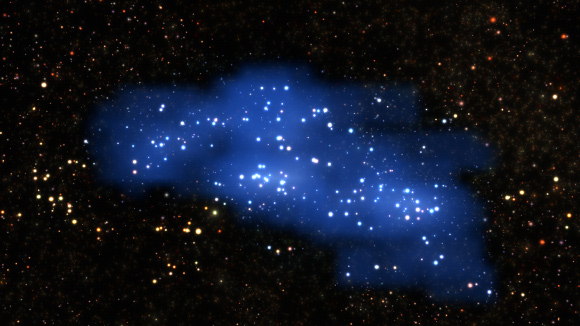Astronomers using ESO’s Very Large Telescope have spotted a gigantic galaxy proto-supercluster in the early Universe, just 2.3 billion years after the Big Bang.

The Hyperion proto-supercluster is the largest and most massive structure yet found at such a remote time and distance — about 2.3 billion years after the Big Bang. Image credit: ESO / L. Calçada & Olga Cucciati et al.
Nicknamed Hyperion, the newly-discovered proto-supercluster is the largest and most massive structure to be found so early in the formation of the Universe.
Its enormous mass is calculated to be more than one million billion times that of the Sun.
“This is the first time that such a large structure has been identified at such a high redshift, just over 2 billion years after the Big Bang,” said lead author Dr. Olga Cucciati, an astronomer at the Istituto Nazionale di Astrofisica, Italy.
“Normally these kinds of structures are known at lower redshifts, which means when the Universe has had much more time to evolve and construct such huge things. It was a surprise to see something this evolved when the Universe was relatively young!”
Located in the COSMOS field in the constellation of Sextans, Hyperion was identified by analyzing the vast amount of data obtained from the VIMOS Ultra-deep Survey (VUDS).
The proto-supercluster has a very complex structure, containing at least seven high-density regions connected by filaments of galaxies, and its size is comparable to nearby superclusters, though it has a very different structure.
“Superclusters closer to Earth tend to a much more concentrated distribution of mass with clear structural features,” said Dr. Brian Lemaux, an astronomer at the University of California, Davis.
“But in Hyperion, the mass is distributed much more uniformly in a series of connected blobs, populated by loose associations of galaxies.”
Given its size so early in the history of the Universe, Hyperion is expected to evolve into something similar to the immense structures in the local Universe such as the superclusters making up the Sloan Great Wall or the Virgo Supercluster that contains our Milky Way Galaxy.
“Understanding Hyperion and how it compares to similar recent structures can give insights into how the Universe developed in the past and will evolve into the future, and allows us the opportunity to challenge some models of supercluster formation,” Dr. Cucciati said.
“Unearthing this cosmic titan helps uncover the history of these large-scale structures.”
The discovery is reported in the journal Astronomy & Astrophysics (arXiv.org preprint).
_____
O. Cucciati et al. 2018. The progeny of a cosmic titan: a massive multi-component proto-supercluster in formation at z=2.45 in VUDS. A&A, in press; doi: 10.1051/0004-6361/201833655







